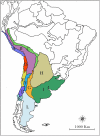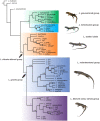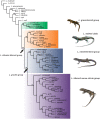Phylogeny, time divergence, and historical biogeography of the South American Liolaemus alticolor-bibronii group (Iguania: Liolaemidae)
- PMID: 29479502
- PMCID: PMC5824678
- DOI: 10.7717/peerj.4404
Phylogeny, time divergence, and historical biogeography of the South American Liolaemus alticolor-bibronii group (Iguania: Liolaemidae)
Abstract
The genus Liolaemus comprises more than 260 species and can be divided in two subgenera: Eulaemus and Liolaemus sensu stricto. In this paper, we present a phylogenetic analysis, divergence times, and ancestral distribution ranges of the Liolaemus alticolor-bibronii group (Liolaemus sensu stricto subgenus). We inferred a total evidence phylogeny combining molecular (Cytb and 12S genes) and morphological characters using Maximum Parsimony and Bayesian Inference. Divergence times were calculated using Bayesian MCMC with an uncorrelated lognormal distributed relaxed clock, calibrated with a fossil record. Ancestral ranges were estimated using the Dispersal-Extinction-Cladogenesis (DEC-Lagrange). Effects of some a priori parameters of DEC were also tested. Distribution ranged from central Perú to southern Argentina, including areas at sea level up to the high Andes. The L. alticolor-bibronii group was recovered as monophyletic, formed by two clades: L. walkeri and L. gracilis, the latter can be split in two groups. Additionally, many species candidates were recognized. We estimate that the L. alticolor-bibronii group diversified 14.5 Myr ago, during the Middle Miocene. Our results suggest that the ancestor of the Liolaemus alticolor-bibronii group was distributed in a wide area including Patagonia and Puna highlands. The speciation pattern follows the South-North Diversification Hypothesis, following the Andean uplift.
Keywords: Ancestral range; Andean uplift; Liolaemus; Lizards; Total evidence.
Conflict of interest statement
Sebastián Quinteros is a researcher of IBIGEO-CONICET, Associate Editor of Cuadernos of Herpetología, and Secretary of the Asociación Herpetológica Argentina. Sabrina Portelli is a Doctoral scholar of CONICET.
Figures








Similar articles
-
A morphology-based phylogeny of the Liolaemus alticolor-bibronii group (Iguania: Liolaemidae).Zootaxa. 2013;3670:1-32. Zootaxa. 2013. PMID: 26438918
-
A new species of the Liolaemus alticolor-bibronii group (Iguania: Liolaemidae) from East-central Argentina.Zootaxa. 2018 Feb 15;4379(4):539-555. doi: 10.11646/zootaxa.4379.4.6. Zootaxa. 2018. PMID: 29689965
-
Two new Liolaemus lizards from the Andean highlands of Southern Chile (Squamata, Iguania, Liolaemidae).Zookeys. 2016 Nov 16;(632):121-146. doi: 10.3897/zookeys.632.9528. eCollection 2016. Zookeys. 2016. PMID: 27920609 Free PMC article.
-
Molecular evidence for a species complex in the patagonian lizard Liolaemus bibronii and phylogeography of the closely related Liolaemus gracilis (Squamata: Liolaemini).Mol Phylogenet Evol. 2007 Jun;43(3):952-73. doi: 10.1016/j.ympev.2006.09.012. Epub 2006 Sep 27. Mol Phylogenet Evol. 2007. PMID: 17116410
-
Hidden diversity within the lizard genus Liolaemus: Genetic vs morphological divergence in the L. rothi complex (Squamata:Liolaeminae).Mol Phylogenet Evol. 2017 Feb;107:56-63. doi: 10.1016/j.ympev.2016.09.009. Epub 2016 Sep 13. Mol Phylogenet Evol. 2017. PMID: 27637991 Review.
Cited by
-
Origin and evolutionary history of Populus (Salicaceae): Further insights based on time divergence and biogeographic analysis.Front Plant Sci. 2022 Dec 16;13:1031087. doi: 10.3389/fpls.2022.1031087. eCollection 2022. Front Plant Sci. 2022. PMID: 36618663 Free PMC article.
-
The micro-niche explains allotopy and syntopy in South American Liolaemus (Iguania: Liolaemidae) lizards.PeerJ. 2025 Feb 17;13:e18979. doi: 10.7717/peerj.18979. eCollection 2025. PeerJ. 2025. PMID: 39981051 Free PMC article.
-
Tracking down the lizards from Gravenhorst's collection at the University of Wrocław: type specimens of Callopistes maculatus Gravenhorst, 1838 and three Liolaemus species rediscovered.PeerJ. 2019 Feb 22;7:e6525. doi: 10.7717/peerj.6525. eCollection 2019. PeerJ. 2019. PMID: 30809465 Free PMC article.
-
Environmental correlates of phenotypic evolution in ecologically diverse Liolaemus lizards.Ecol Evol. 2022 Jun 16;12(6):e9009. doi: 10.1002/ece3.9009. eCollection 2022 Jul. Ecol Evol. 2022. PMID: 35784059 Free PMC article.
References
-
- Abdala CS. Phylogeny of the boulengeri group (Iguania: Liolaemidae, Liolaemus) based on morphological and molecular characters. Zootaxa. 2007;1538:1–84.
-
- Abdala CS, Quinteros AS. Los últimos 30 años de estudios de la familia de lagartijas más diversa de Argentina. Actualización taxonómica y sistemática de Liolaemidae. Cuadernos de Herpetología. 2014;28(2):55–82.
-
- Abdala CS, Quinteros AS, Semham RV. A new species of Liolaemus of the Liolaemus alticolor-bibronii Group (Iguania: Liolaemidae) from Mendoza, Argentina. South American Journal of Herpetology. 2015;10(2):104–115. doi: 10.2994/SAJH-D-14-00033.1. - DOI
-
- Aguilar C, Wood Jr PL, Cusi JC, Guzmán A, Huari F, Lundberg M, Sites Jr JW. Integrative taxonomy and preliminary assessment of species limits in the Liolaemus walkeri complex (Squamata, Liolaemidae) with descriptions of three new species from Perú. ZooKeys. 2013;364:47–91. doi: 10.3897/zookeys.364.6109. - DOI - PMC - PubMed
-
- Albino AM. Lagartos iguanios del Colhuehuapense (Mioceno Temprano) de Gaiman (provincia del Chubut, Argentina) Ameghiniana. 2008;45:775–782.
LinkOut - more resources
Full Text Sources
Other Literature Sources
Research Materials

